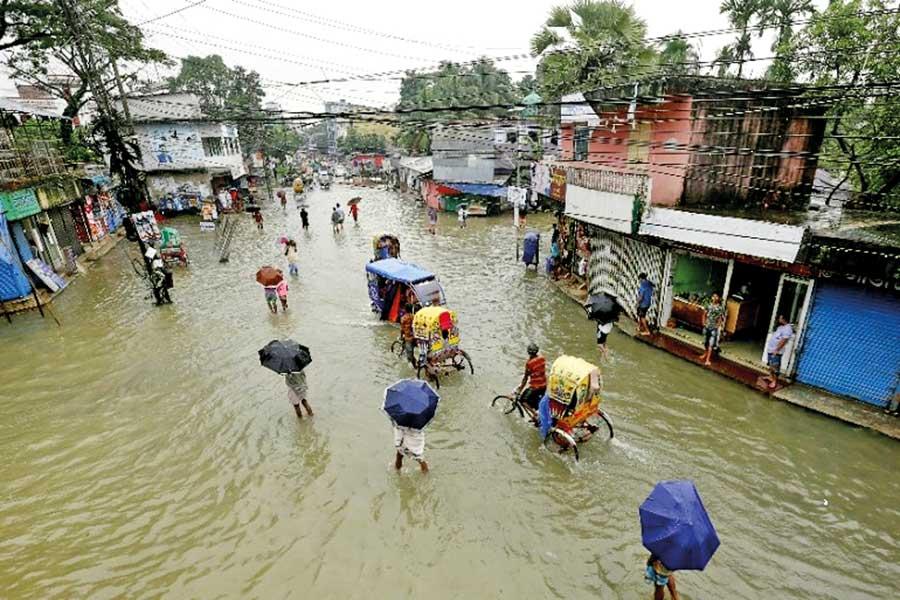Reply To:
Name - Reply Comment

Bangladesh with its myriad rivers, deltas and low-lying plains has a geographical problem where flooding is concerned. (Image courtesy : AFP)
Natural disasters affect all three countries much more than Sri Lanka, and the economies of all three are troubled. And yet, especially in the case of Bangladesh and Pakistan which lack the massive human and natural resources of their giant neighbour, they were able to help us financially
We get so mired in our own problems that it’s easy to forget what’s happening elsewhere in the world. I’m not talking about the recession that’s now beginning to bite into the economies of Europe and elsewhere.
economies of Europe and elsewhere.
This is a convenient excuse for the Rajapaksa lobby to pretend that our problems are not unique. They would like us to forget that the roots of our disaster can be traced directly to Gotabaya Rajapaksa’s two years of obtuse misrule, and the profligacy of his family dynasty when his brother Mahinda was president. Or, if you want to believe the GMOA, 74 years of corruption and misrule (how much did D.S. Senanayake, Dudley, S.W.R.D. and Sirimavo Bandaranaike and their daughter Chandrika have in their offshore accounts when they left office?).
No, this isn’t about world recession and the war in Ukraine. That’s a general disaster that’s blighting the entire world. But countries have specific problems.
When the Gotabaya regime had no foreign exchange to buy fuel, food and medicines, our immediate neighbours offered help. They did so while coping with unusually grave climatic and other mitigating factors.
This is about the floods in Bangladesh and Pakistan.
As for the rain and floods, people everywhere are finally waking up to the reality of climate change. Deforestation has a lot to do with this. Both Bangladesh and Pakistan were seriously affected by torrential rains and floods this year.
Natural disasters affect all three countries much more than Sri Lanka, and the economies of all three are troubled. And yet, especially in the case of Bangladesh and Pakistan which lack the massive human and natural resources of their giant neighbour, they were able to help us financially. This speaks volumes for their self-confidence as nations. Moving from debtor status to creditor is a paradigm shift in the image of a nation.
Bangladesh with its myriad rivers, deltas and low-lying plains has a geographical problem where flooding is concerned. The country has over 700 rivers if one counts all the tributaries.
With a population of over 41.7 million people, Bangladesh is still ranked as a Less Economically Developed Country (LEDC) though it is steadily moving away from that status. The population below the poverty line in 2010 was about 31.5% of the whole population.
The country’s well known for experiencing devastating annual floods. Home to the world’s three most powerful rivers, Bangladesh has an increased flooding propensity since the late 1990s.
The government has built a series of embankments costing $6 billion around the two largest rivers. These are 7,555km long and 7m height -- essentially a wall built from cobble, stone and earth.
Aside from embankments, Bangladesh also has built 5000 flood shelters around the country to help citizens survive flooding.
The deforestation of Himalayan foothills is a main reason for the flooding in Bangladesh. This allows more rainwater to reach the Ganges and Brahmaputra.
Another reason is the increasing demand for fresh water as a result of rising population figures. The Ganges has been widely used by the local population for irrigation, industrial water supply and agriculture. These human activities result in the loss of silt from the river load, which hinders the natural construction of the floodplain. The government has also built about 100,000 wells to satisfy people’s fresh water demands. But this has reduced the water table and the land level by 2.5cm annually. As the land level goes down, the country is at greater risk of flooding.
The tectonic uplift of the Himalayas is another contributing factor. This mass of residue is dumped in Bangladesh, choking the river channels.
Even with all these problems, and despite widespread corruption and political discontent, Bangladesh has made great strides economically in recent years.
Bangladesh’s GDP is about the size of the Pakistani and Sri Lankan economies combined. Bangladesh’s foreign currency reserves are $39 billion, more than twice the $18 billion of the other two countries. According to the finance ministry, Bangladesh’s total debt-to-GDP ratio stands at just over 31 percent, compared with 119 percent for Sri Lanka. Bangladesh has a higher per capita GDP than India and is outperforming other major South Asian nations in key socioeconomic metrics.
Bangladesh has $45 billion in foreign reserves, an amount large enough to fund imports for six months. That’s how it was able to loan $200 million to Sri Lanka through a currency swap mechanism.
Prime Minister Sheikh Hasina has pledged that her country will not fall into the same trap as Sri Lanka. But there are some disturbing socio-political similarities between the two. Both are ruled by oligarchies, inviting large-scale corruption, and Sheikh Hasina’s government too, has been accused of spending too much on politically-motivated megaprojects such as the massive Padma bridge. But a bridge can be used by all Bangladeshi citizens, unlike our Rajapaksa-era airports in the middle of nowhere and ports which serve China more than us, and highways without slow lanes which totally ignore the masses with their motorcycles and three wheelers.
As for Pakistan, its economy too, is in a perilous state. Things were made worse by unprecedented rains and flooding this year which caused massive damage to cash crops such as sugarcane. Pakistan, an exporter of wheat, may have to import stocks from Russia as a result of flood damage.
Serious deforestation is a major reason for increasing rainfall. But the situation is hard to control as 68% of Pakistani families use firewood for domestic use. Based on this, Pakistan is in a state of ‘Green Emergency’.
The government has made serious efforts at reforestation, but increasing population demands and business concerns have been major setbacks.
According to global forest watch date, in 2010 Pakistan had 648kha of tree cover, extending over 0.74% of its land area. In 2021, it lost 63.2ha of tree cover, equivalent to 23.5kt of CO₂ emissions. As of 2000, only 1.1% of Pakistan was natural forest cover.
Seasonal fires are another contributing factor. From 2001 to 2021, Pakistan lost 5.46kha of tree cover from fires and 4.29kha from all other drivers of loss. In Pakistan the peak fire season begins in mid-January and lasts around 24 weeks.
Despite serious deforestation, sand mining and other factors damaging the environment, Sri Lanka is blessed by nature compared to Bangladesh and Pakistan. And yet, we are now struggling at the bottom of the heap, with the sixth highest child malnutrition rate in the world, our educational, healthcare, welfare systems and much else at shambles and with no foreign exchange reserves left to pay for many essential items, and those who can scrambling to leave the country.